MITSUBISHI MIRAGE G4 2020 Owner's Manual (in English)
Manufacturer: MITSUBISHI, Model Year: 2020, Model line: MIRAGE G4, Model: MITSUBISHI MIRAGE G4 2020Pages: 253, PDF Size: 36.39 MB
Page 161 of 253
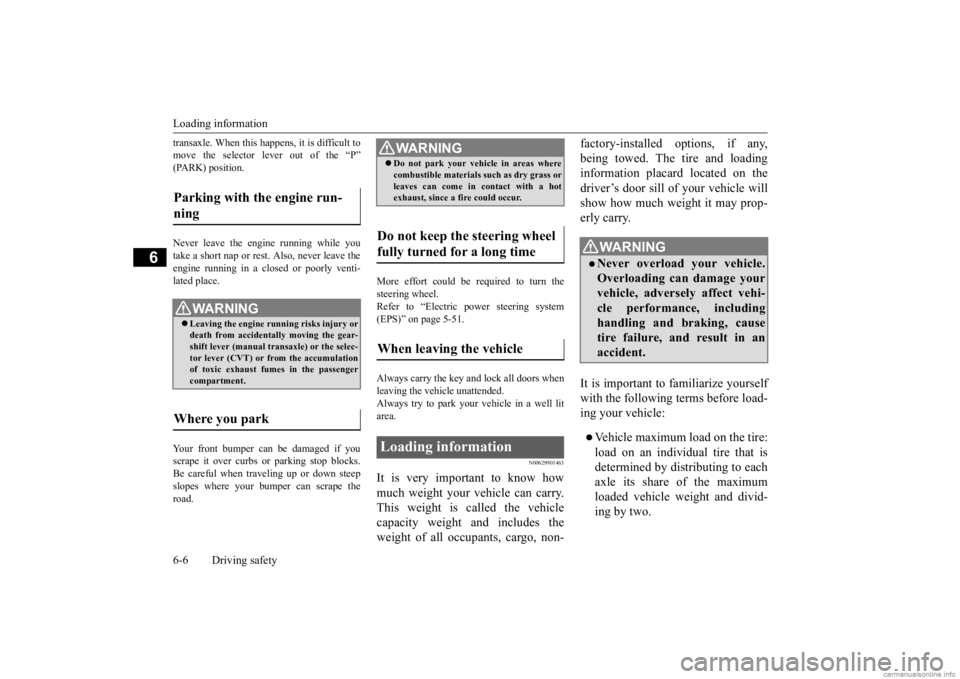
Loading information 6-6 Driving safety
6
transaxle. When this ha
ppens, it is difficult to
move the selector lever out of the “P”(PARK) position. Never leave the engine running while you take a short nap or rest. Also, never leave the engine running in a closed or poorly venti- lated place. Your front bumper can be damaged if you scrape it over curbs or parking stop blocks. Be careful when traveling up or down steep slopes where your bumper can scrape theroad.
More effort could be required to turn the steering wheel. Refer to “Electric
power steering system
(EPS)” on page 5-51. Always carry the key and lock all doors when leaving the vehicle unattended. Always try to park your vehicle in a well lit area.
N00629901463
It is very important to know how much weight your vehicle can carry. This weight is called the vehicle capacity weight and includes theweight of all occupants, cargo, non-
factory-installed options, if any, being towed. The tire and loading information placard located on the driver’s door sill of your vehicle willshow how much weight it may prop- erly carry. It is important to familiarize yourself with the following
terms before load-
ing your vehicle:Vehicle maximum load on the tire:load on an individual tire that isdetermined by distributing to each axle its share of the maximum loaded vehicle weight and divid-ing by two.
Parking with the engine run- ning
WA R N I N G Leaving the engine ru
nning risks injury or
death from accidentally moving the gear-shift lever (manual transaxle) or the selec- tor lever (CVT) or from the accumulation of toxic exhaust fumes in the passengercompartment.
Where you park
WA R N I N G Do not park your vehicle in areas where combustible materials
such as dry grass or
leaves can come in contact with a hotexhaust, since a fire could occur.
Do not keep the steering wheel fully turned for a long time When leaving the vehicle Loading information
WA R N I N GNever overload your vehicle. Overloading can damage your vehicle, adversely affect vehi-cle performance, including handling and braking, cause tire failure, and result in anaccident.
BK0284300US.book 6 ページ 2019年5月23日 木曜日 午後12時22分
Page 162 of 253

Loading information Driving safety 6-7
6
Vehicle normal load on the tire: load on an individual tire that is determined by distributing to each axle its share of the curb weight,accessory weight, and normal occupant weight and dividing by two.Maximum loaded vehicle weight: the sum of - (a) Curb weight;(b) Accessory weight; (c) Vehicle capacity weight; and (d) Production options weight.Curb weight: the weight of a motor vehicle with standard equipment including the maxi-mum capacity of fuel, oil, and coolant.
Accessory weight: the combined weight (in excess of those stan- dard items which may be replaced) of automatic transmis-sion, power steering, power brakes, power windows, power seats, radio, and heater, to theextent that these items are avail- able as factory- installed equip- ment (whether installed or not).Vehicle capacity weight: the rated cargo and luggage load plus 150 lbs (68 kg)
* times the vehicle’s
designated seating capacity.Production options weight: thecombined weight of thoseinstalled regular production options weighing over 5 lbs (2.3 kg) in excess of those standarditems which they
replace, not pre-
viously considered in curb weight or accessory weight, includingheavy duty brakes, ride levelers,roof rack, heavy duty battery, and special trim.
Normal occupant weight: 150 lbs (68 kg)
* times the number of
specified occupants. (In your vehicle the number is 3)Occupant distribution: Occupant distribution within the passenger compartment (In your vehicle thedistribution is 2 in front, 1 in sec- ond row seat) * : 150 lbs (68 kg) is the weight of one person as defined by U.S.A. regulations.
BK0284300US.book 7 ページ 2019年5月23日 木曜日 午後12時22分
Page 163 of 253
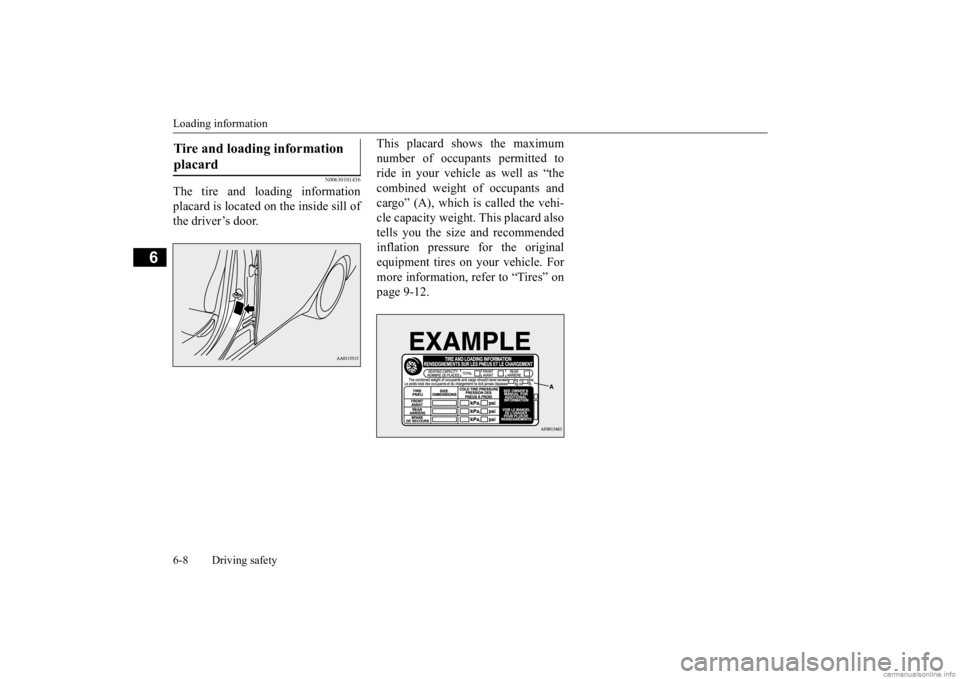
Loading information 6-8 Driving safety
6
N00630101436
The tire and loading information placard is located on the inside sill of the driver’s door.
This placard shows the maximum number of occupants permitted to ride in your vehicle as well as “the combined weight of occupants andcargo” (A), which is called the vehi- cle capacity weight. This placard also tells you the size and recommendedinflation pressure for the original equipment tires on your vehicle. For more information, refer to “Tires” onpage 9-12.
Tire and loading information placard BK0284300US.book 8 ページ 2019年5月23日 木曜日 午後12時22分
Page 164 of 253

Loading information Driving safety 6-9
6
N00630201280
1.Locate the statement “The com- bined weight of occupants and cargo should never exceed XXX kg or XXX lbs.” on your vehicle’splacard.2.Determine the combined weightof the driver and passengers thatwill be riding in your vehicle.3.Subtract the combined weight ofthe driver and passengers fromXXX kg or XXX lbs.4.The resulting figu
re equals the
available amount of cargo andluggage load capacity. For exam- ple, if the “XXX” amount equals 1400 lbs. and there will be five150 lbs. passengers in your vehi- cle, the amount of available cargo and luggage load
capacity is 650
lbs. (1400 - 750 (5 x 150) = 650lbs.)
5.Determine the combined weightof luggage and cargo being loaded on the vehicle. That weight may not safely exceed the availablecargo and luggage load capacity calculated in Step 4.6.If your vehicle will be towing a trailer, load from your trailer will be transferred to your vehicle. Consult this manual to determinehow this reduces the available cargo and luggage load capacity of your vehicle.
Steps for Determining Correct Load Limit
NOTE
The above steps for determining correct load limit were written in accordance with U.S.A. regula- tions.Your vehicle cannot tow a trailer, so step 6 is irrelevant.
BK0284300US.book 9 ページ 2019年5月23日 木曜日 午後12時22分
Page 165 of 253
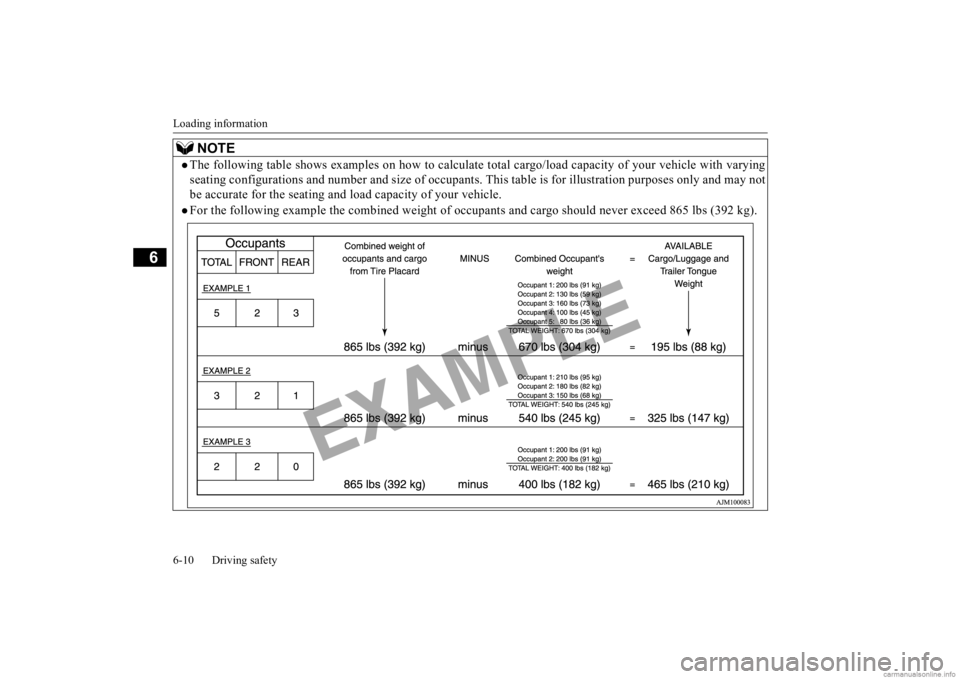
Loading information 6-10 Driving safety
6
NOTE
The following table shows examples on ho
w to calculate total cargo/load capac
ity of your vehicle with varying
seating configurations and number and si
ze of occupants. This table is for
illustration purposes only and may not
be accurate for the seating and
load capacity of your vehicle.
For the following example th
e combined weight of occupants and cargo
should never exceed 865 lbs (392 kg).
BK0284300US.book 10 ページ 2019年5月23日 木曜日 午後12時22分
Page 166 of 253
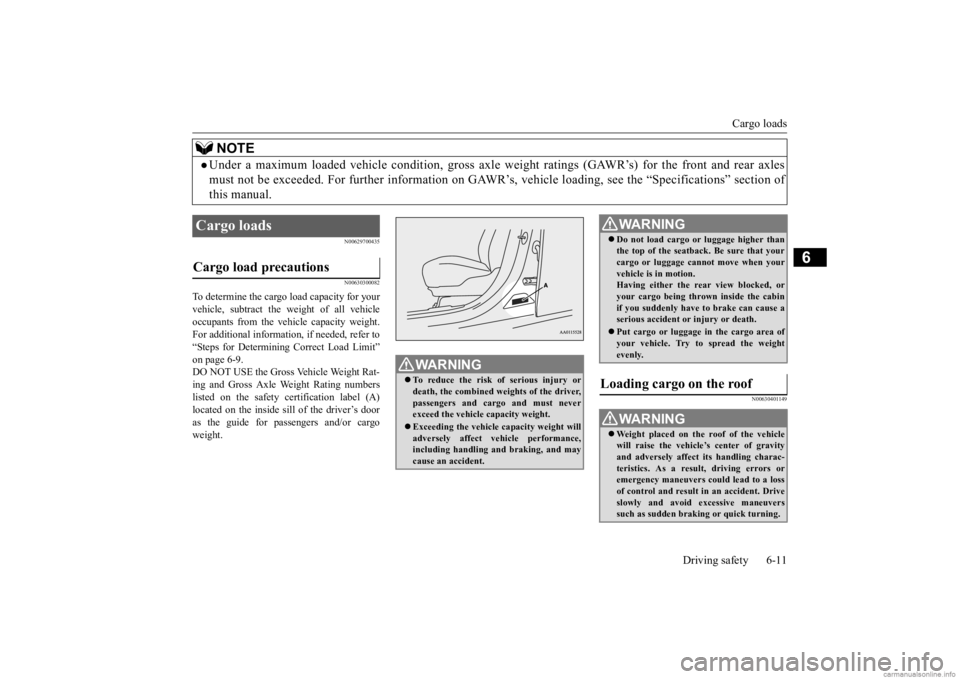
Cargo loads
Driving safety 6-11
6
N00629700435 N00630300082
To determine the cargo load capacity for your vehicle, subtract the
weight of all vehicle
occupants from the vehi
cle capacity weight.
For additional information, if needed, refer to “Steps for Determining Correct Load Limit” on page 6-9.DO NOT USE the Gross Vehicle Weight Rat- ing and Gross Axle
Weight Rating numbers
listed on the safety certification label (A)located on the inside sill of the driver’s door as the guide for passengers and/or cargo weight.
N00630401149
Under a maximum loaded vehicle condi
tion, gross axle weight ratings (GAWR’s) for the front and rear axles
must not be exceeded. For further information on GAWR’s
, vehicle loading, see the
“Specifications” section of
this manual.NOTE
Cargo loads Cargo load precautions
WA R N I N G To reduce the risk of serious injury or death, the combined weights of the driver,passengers and cargo and must never exceed the vehicle capacity weight. Exceeding the vehicle capacity weight will adversely affect vehicle performance, including handling an
d braking, and may
cause an accident.
Do not load cargo or
luggage higher than
the top of the seatback. Be sure that yourcargo or luggage cann
ot move when your
vehicle is in motion. Having either the re
ar view blocked, or
your cargo being thrown inside the cabin if you suddenly have to brake can cause a serious accident or
injury or death.
Put cargo or luggage in the cargo area of your vehicle. Try to spread the weightevenly.
Loading cargo on the roof
WA R N I N G Weight placed on the
roof of the vehicle
will raise the vehicle’
s center of gravity
and adversely affect its handling charac-teristics. As a result, driving errors or emergency maneuvers could lead to a loss of control and result in an accident. Driveslowly and avoid excessive maneuvers such as sudden brak
ing or quic
k turning.
WA R N I N G
BK0284300US.book 11 ページ 2019年5月23日 木曜日 午後12時22分
Page 167 of 253
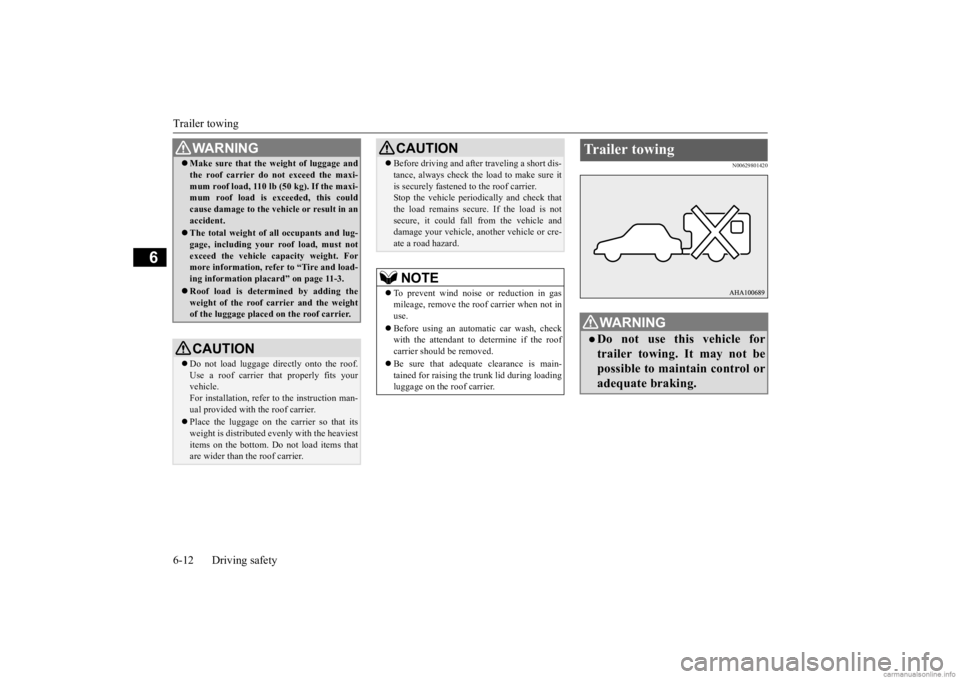
Trailer towing 6-12 Driving safety
6
N00629801420
Make sure that the weight of luggage and the roof carrier do not exceed the maxi-mum roof load, 110 lb (50 kg). If the maxi-mum roof load is ex
ceeded, this could
cause damage to the ve
hicle or result in an
accident. The total weight of all occupants and lug- gage, including your r
oof load, must not
exceed the vehicle capacity weight. For more information, refer to “Tire and load- ing information placard” on page 11-3. Roof load is determined by adding the weight of the roof
carrier and the weight
of the luggage placed
on the roof carrier.
CAUTIONDo not load luggage directly onto the roof. Use a roof carrier that properly fits your vehicle. For installation, refer to the instruction man-ual provided with the roof carrier. Place the luggage on the carrier so that its weight is distri
buted evenly with the heaviest
items on the bottom. Do not load items that are wider than the roof carrier.WA R N I N G
Before driving and after traveling a short dis- tance, always check the load to make sure itis securely fastened to the roof carrier.Stop the vehicle periodi
cally and check that
the load remains secure. If the load is not secure, it could fall from the vehicle anddamage your vehicle,
another vehicle or cre-
ate a road hazard.NOTE
To prevent wind noise or reduction in gas mileage, remove the roof carrier when not in use. Before using an automatic car wash, check with the attendant to determine if the roofcarrier should be removed. Be sure that adequate clearance is main- tained for raising the trunk lid during loading luggage on the roof carrier.CAUTION
Trailer towing
WA R N I N GDo not use this vehicle for trailer towing. It may not bepossible to maintain control or adequate braking.
BK0284300US.book 12 ページ 2019年5月23日 木曜日 午後12時22分
Page 168 of 253
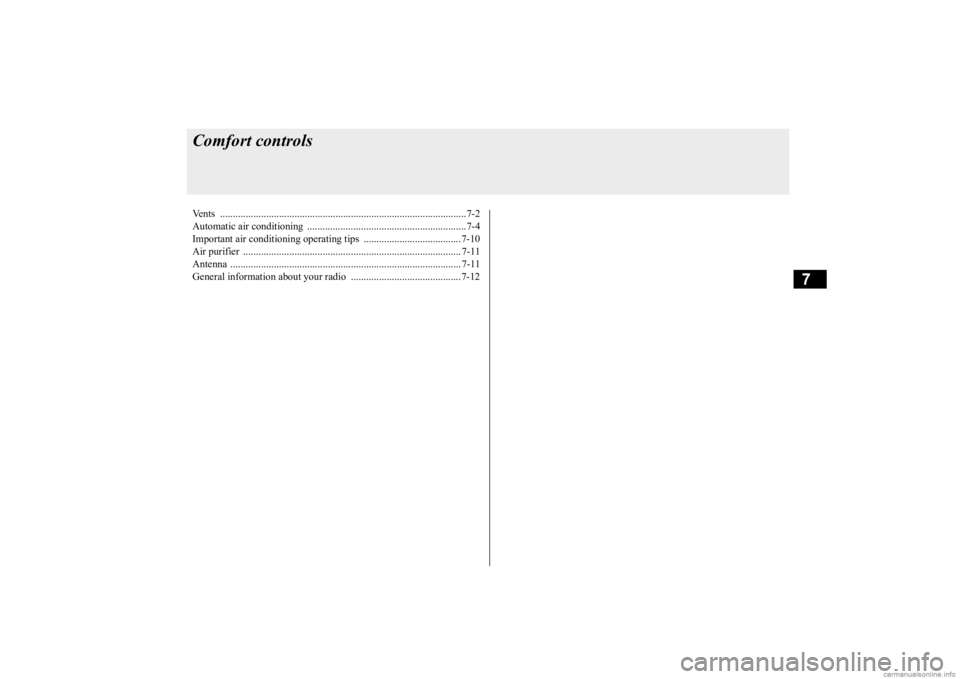
7
Comfort controlsVents ................................................................................................7-2 Automatic air conditioning ..............................................................7-4 Important air conditioning operating tips ..
...........
...........
.........
.....7-10
Air purifier ..................................................................................... 7-11 Antenna .......................................................................................... 7-11 General information about your radio .....
...........
...........
...........
.....7-12
BK0284300US.book 1 ページ 2019年5月23日 木曜日 午後12時22分
Page 169 of 253
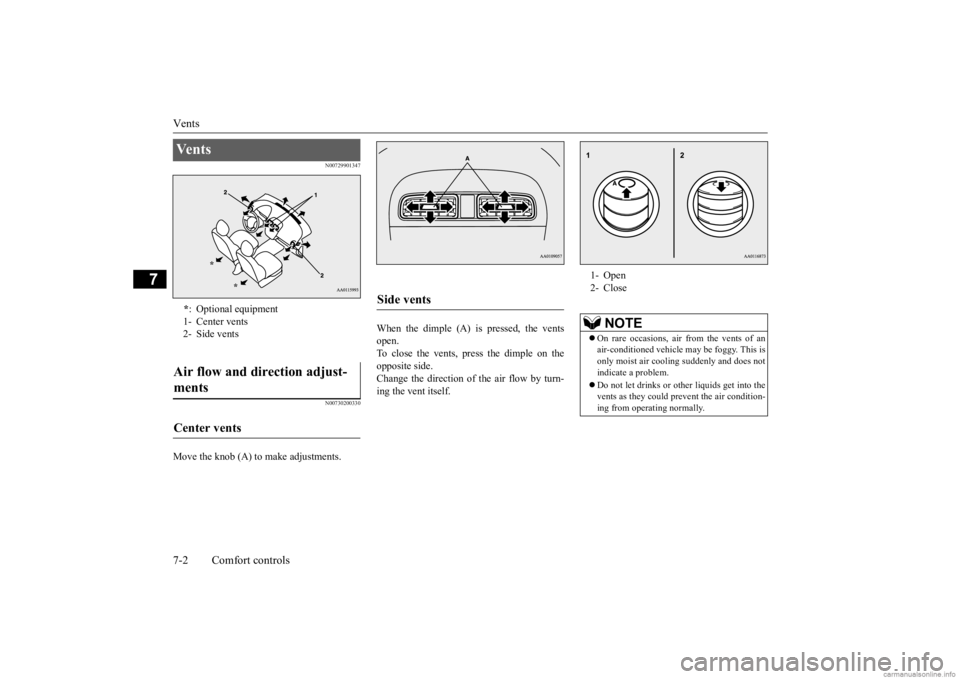
Vents 7-2 Comfort controls
7
N00729901347 N00730200330
Move the knob (A) to make adjustments.
When the dimple (A) is pressed, the vents open. To close the vents, press the dimple on the opposite side.Change the direction of the air flow by turn- ing the vent itself.
Ve n t s * : Optional equipment 1- Center vents2- Side ventsAir flow and direction adjust- ments Center vents
*
*
Side vents
1- Open 2- Close
NOTE
On rare occasions, air from the vents of an air-conditioned vehicle
may be foggy. This is
only moist air cooling suddenly and does not indicate a problem. Do not let drinks or ot
her liquids get into the
vents as they could pr
event the air condition-
ing from operating normally.
BK0284300US.book 2 ページ 2019年5月23日 木曜日 午後12時22分
Page 170 of 253
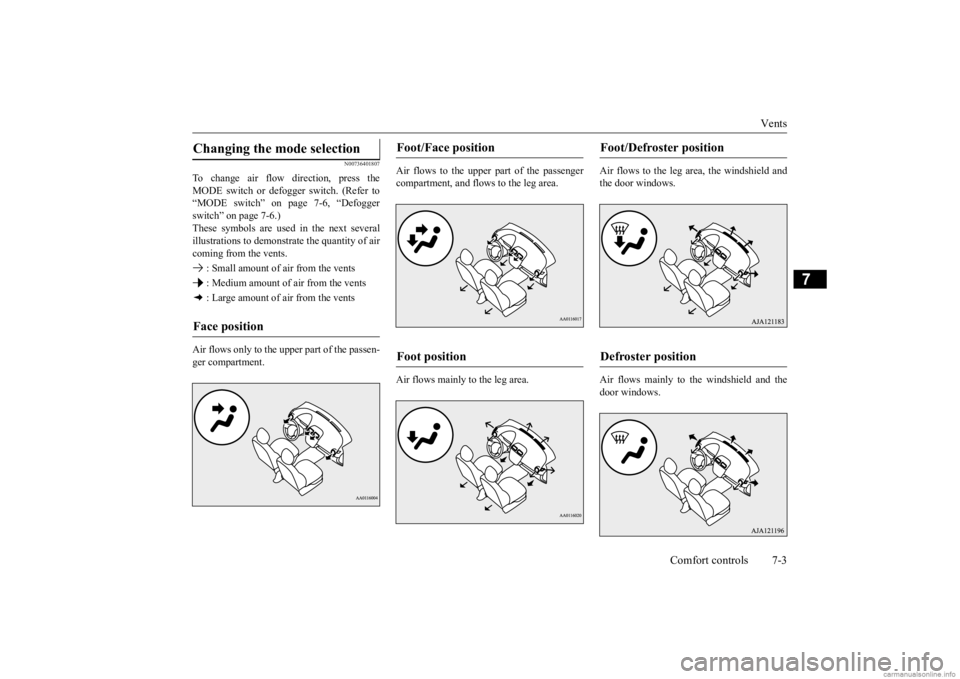
Vents
Comfort controls 7-3
7
N00736401807
To change air flow direction, press the MODE switch or defogger switch. (Refer to “MODE switch” on page 7-6, “Defoggerswitch” on page 7-6.) These symbols are used in the next several illustrations to demonstr
ate the quantity of air
coming from the vents. : Small amount of air from the vents : Medium amount of air from the vents : Large amount of air from the vents Air flows only to the upper part of the passen- ger compartment.
Air flows to the upper part of the passenger compartment, and flows to the leg area. Air flows mainly to the leg area.
Air flows to the leg area, the windshield and the door windows. Air flows mainly to the windshield and the door windows.
Changing the mode selection Face position
Foot/Face position Foot position
Foot/Defroster position Defroster position
BK0284300US.book 3 ページ 2019年5月23日 木曜日 午後12時22分